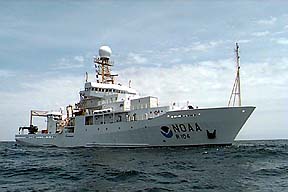
Joint Air-Sea Monsoon Investigation: JASMINE
Monsoon circulations cause phenomenal seasonal variations of precipitation in some of the planet's most heavily populated regions. The ability to predict the timing and intensity of monsoons is of huge importance to the well-being of nations in these areas and is also important to understanding global climate conditions.
The Joint Air-Sea Monsoon Investigation (JASMINE) is a multi-agency study of the Asian-Australian monsoon system. A pilot study in 1999 using the NOAA research vessel Ron Brown preceded the main experiment in 2000. The project examined the dynamical and thermodynamical connections of the upper ocean and the lower atmosphere in the northern Indian Ocean where maximum seasonal variations in precipitation occur. The ship supported a variety of scientific in-situ and remote sensor instruments, including ESRL's millimeter-wave cloud radar (MMCR) package which includes microwave and infrared radiometers in addition to the high-sensitivity 35-GHz radar designed for cloud observations. The ship's instruments measured interactions between the ocean surface and the atmospheric boundary layer, in conjunction with research aircraft and buoy-mounted probes in the area.